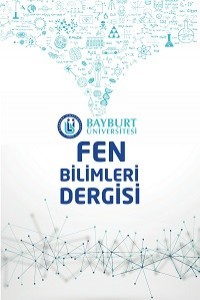Bir Perakende Firmasında Metin Benzerliği ve Tekil Değer Ayrışımı Algoritması Tabanlı Ürün Öneri Sisteminin Oluşturulması
Ürün Öneri Sistemi, E-Ticaret, Metin Benzerliği, Tekil Değer Ayrışımı
Creating a Text Similarity and Singular Value Decomposition Algorithm Based Product Recommendation System in a Retail Company
___
- [1] G. Adomavicius, A. Tuzhilin, “Toward the next generation of recommender systems: A survey of the stateof-the-art and possible extensions,” IEEE Transactions on Knowledge and Data Engineering, vol. 17, no. 6. 2005.
- [2] B. Sarwar, G. Karypis, J. Konstan, J. Riedl, "Item-based collaborative filtering recommendation algorithms", Proceedings of the tenth international conference on World Wide Web - WWW ’01, New York., 285-295, 2001.
- [3] C. A. Gomez-Uribe, N. Hunt, “The netflix recommender system: Algorithms, business value, and innovation,” ACM Trans. Manag. Inf. Syst., vol. 6, no. 4, 2015.
- [4] B. Smith, G. Linden, “Two Decades of Recommender Systems at Amazon.com,” IEEE Internet Comput., vol. 21, no. 3, 2017.
- [5] S. Qin, R. Menezes, M. Silaghi, “A recommender system for youtube based on its network of reviewers”, 2010.
- [6] M. Schedl, H. Zamani, C. W. Chen, Y. Deldjoo, M. Elahi, “Current challenges and visions in music recommender systems research,” Int. J. Multimed. Inf. Retr., vol. 7, no. 2, 2018.
- [7] E. Yalçın, “İşbirlikçi Filtreleme Algoritmalarının Çok-Beğenilen Ürünlere Yönelik Yanlılığı”, BŞEÜ Fen Bilimleri Dergisi, vol. 8, no. 1, pp. 279-291, 2021.
- [8] L. Zhaoyang, “Matris Ayrışımı,” İstanbul Üniversitesi, Sosyal Bilimler Enstitüsü, Ekonometri Anabilim Dalı, Yüksek Lisans Tezi, 1993.
- [9] A. Dundar, A. Gorgulu Kakisim, “Kıyafet Öneri Sistemi için Giyim Metaverilerine Dayalı Temsil Öğrenimi”, Avrupa Bilim ve Teknoloji Dergisi, vol. 29, pp. 105-110. 10, 2021.
- [10] Y. K. Choi and S. K. Kim, “An auxiliary recommendation system for repetitively purchasing items in Ecommerce,” 2014, doi: 10.1109/BIGCOMP.2014.6741415.
- [11] H. Alharthi, D. Inkpen, and S. Szpakowicz, “A survey of book recommender systems,” J. Intell. Inf. Syst.,vol. 51, no. 1, 2018.
- [12] S. Guler, “Öneri Sistemleri ve E-Ticarette Öneri Sistemlerinin Kullanımı”, Sakarya Üniversitesi, FenBilimleri Enstitüsü, Bilgisayar ve Bilişim Mühendisliği, Yüksek Lisans Tezi. 2019.
- [13] M. Uçar, “E-Ticaret Siteleri için Bulanık Mantık ve Makine Öğrenmesi Tabanlı bir Öneri Sistemi”, Sakarya Üniversitesi, Fen Bilimleri Enstitüsü, Bilgisayar ve Bilişim Mühendisliği, Yüksek Lisans Tezi, 2021.
- [14] E. Yıldız, “Müşteri Segmentasyonu Odaklı Bütünleşik Bir Ürün Öneri Sistemi: Moda Perakendesi Sektöründe Bir Uygulama”, Yıldız Teknik Üniversitesi, Fen Bilimleri Enstitüsü, Endüstri Mühendisliği, Yüksek Lisans Tezi, 2018.
- [15] B. Batmaz, “Yükseköğretimde Öneri Sistemlerine Dayalı Ders Seçme Modeli”, Eskişehir Osmangazi Üniversitesi, Fen Bilimleri Enstitüsü, İstatistik Bilgi Sistemleri, Doktora Tezi, 2018.
- [16] Ü. Keleş, N. Duru, “Metin Benzerliği Algoritmaları ile Veri Tekilleştirme: Oteller Veri Tabanında Bir Uygulama”, Türkiye Bilişim Vakfı Bilgisayar Bilimleri ve Mühendisliği Dergisi, vol:5, no:1, 2021.
- [17] R. T. Ionescu, M. Popescu, “Knowledge Transfer between Computer Vision and Text Mining”, Switzerland: Springer, 2016.
- [18] Z. Li, “Matris Ayrışımı”, İstanbul Üniversitesi, Sosyal Bilimler Enstitüsü. Ekonometri Anabilim Dalı,Yüksek Lisans Tezi, 2006.
- [19] T. F. Abidin, B. Yusuf, M. Umran, “Singular Value Decomposition for Dimensionality Reduction in Unsupervised Text Learning Problems”, 2nd International Conference on Education Technology and Computer (ICETC), vol. 4, pp. 422–426, 2010.
- [20] J. Han, J. Pei, M. Kamber, “Data mining: concepts and techniques”, 3rd Edition, Morgan Kaufmann Publishers, vol.7, no.6, 2011.
- Yayın Aralığı: Yılda 2 Sayı
- Başlangıç: 2018
- Yayıncı: Bayburt Üniversitesi
Mehmet TÜRKMENOĞLU, Bayram Ali MERT, Mesut ANIL
Yenilikçi Tasarım Bakış Açısıyla İnsansı Robot Kol Parçası Tasarımı
Safer ÇOKATAR, Muhammet Tarık YILDIRIM, Hüseyin Hakkı BULDUK, Oğuzhan Sefa GÜNER, Ersin TOPTAŞ
Polygonum longipes (Polygonaceae) Türünün 124 Yıl Sonra Yeniden Keşfi
Mustafa KESKİN, Zeki SEVEROĞLU
Sonlu Elemanlar Analiz Yöntemi Kullanılarak Blower Çark Tasarımının İyileştirilmesi
Lezgin KAYA, Betül GENÇASLAM, Sezgin BALCİ
Polianilin Kaplı Prinç Kabuğunun Atrazin Giderimi Üzerine Etkinliği
Uzamsal Alanda Bir Kripto-Stegano Hibrit Uygulama
Ağır Metal Ekstraksiyonu için Patlıcan Bazlı Biyosorbentler
Doğu RAMAZANOĞLU, Zaman Adnan MOHAMMED, Idrees KHALO, Khalid MAHER
Kurkuminin SARS-CoV-2 Üzerindeki Antiviral Etkileri Üzerine Moleküler Kenetlenme Analizi
